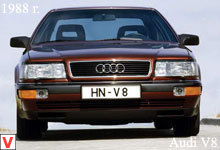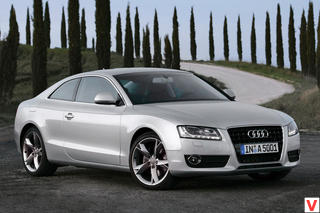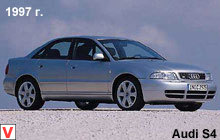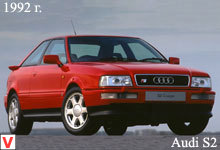
Audi 80 "Audi-80" debuted in 1972 and soon won the prestigious title of "Car of the Year." In August 1986, the third generation went off the assembly line in Ingolstadt (body series - 89). At the same time, they also started producing the all-wheel drive version (the 89Q series) under the Audi name Quattro with the same engines as the Audi 80, except for diesel engines. Audi of this generation, for its distinctive “full” body shape, was nicknamed “barrel” in Russia. The strength and corrosion resistance of a fully galvanized body, as well as the trim and the driver's seat, designed to meet all the requirements for ergonomics, deserve high marks.
High comfort is ensured by the operation of the suspension, which is confident on expressways and on a dirt road (good, naturally) and moderately sensitive, but at the same time accurate steering. That's just not all versions are power steering and quite small (425 l) trunk. Yes, and landing passengers behind is quite uncomfortable because of too vertical seat back, as well as limited space above your head. In front of the cabin everything is almost perfect, except ...
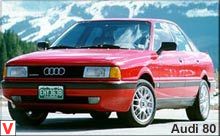
there is no lighting. In addition to the four-cylinder fuel-efficient 75-horsepower carburetor engines with a displacement of 1.6 liters and 1.8 liters of 90 hp with central injection and a neutralizer, as well as a 1.8-, 1.9-liter 112-113-strong with an injection system (power is standardized due to the peculiarities of the German tax system), a four-cylinder 54-strong 1.6-liter was installed on the cars diesel, which for a long time remained the most economical among such units. Since July 1988, the 113 80-strong 1964-cube “four” began to be installed on the Audi 80. At the same time, the production of a 1.6-liter turbodiesel with an output of 80 hp was also launched.
(75 hp with a catalytic converter), and from 1989 they added a 68-horsepower 1.9-liter diesel engine. In September 1987, sales of Audi 90 sedans began, which were slightly higher than the “80th” in terms of equipment and trim, but were equipped with more powerful power units: four-cylinder petrol with a central injection system of 2.0 liters (115 hp .), which ousted the outdated 1.9-liter “fours” from the production program; five-cylinder - 2.0-liter (115 hp) and 2, The 3-liter 136-horsepower (which since February 1987 has become the main export one, for the US market, the Audi 80).
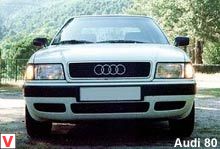
Gamma was also supplemented with the latest 20-valve, 160-horsepower, fuel-efficient 2.0-and 2.3-liter engines, which were also used for the Quattro version. All models produced since February 1987 have been adjusted to European and US standards in terms of exhaust gas toxicity. In 1991, the Audi 80 was restyled (body series - B4). Changed the design of its front and rear. The grille is made together with the hood (a la "Mercedes"). Bumpers of a different shape began to be painted to match the body color. The 15-inch wheels became regular; access to the trunk is more convenient; it has become possible to increase it from 430 to 710 liters due to the reclining rear seat backrest.
Model Audi 90 removed from production. For those who like to save from August 1991, they have mastered the super-economical (8.0 l / 100 km in the urban cycle) 90-strong turbo diesel with direct fuel injection. Audi 80 Avant wagon appeared later.

The first five-door Audi was introduced in June 1992 on the growing crest of the popularity of cars for the family. Their trunk can be consistently increased from 370 to 650 liters and up to a maximum of 1,200 liters (with the second row of seats partially or fully unfolded), which makes it possible to transport, if not a bulky sports equipment, then a large dog - definitely. But as a vehicle for active recreation, Avant was a success mainly due to the integral transmission and the newly emerged V-shaped 2.6-liter 150-horsepower injection "six".
A year later, her 2.8-liter 174-strong version arrived, with which fuel consumption in urban areas is only 13 liters per 100 kilometers, and the maximum speed is 220 km / h. But the real sports versions of station wagons and hatchbacks appeared on the streets in January 1993 - these were the S2 Avant with a 230-horsepower 2.2-liter inline five-cylinder engine and a tougher sports suspension. In order to keep within the passport 14 liters per 100 km of run in the urban cycle, it is not necessary to switch gears five-speed, manual gearbox. The forced engine perfectly realizes its cyclopean 380 Nm of torque in a wide range (2100-4000 1 / min).
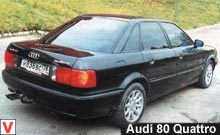
The external differences of this version were reduced to bumpers with large air intakes, Porsche-type brakes (with bright red calipers) and "S2" nameplates. The interior has changed a lot: the motley fabric trim, other instrument panel, sports steering wheel, etc. From this period, all models (series B4) begin to complete with hatches in the roof (as standard). In May 1994, the public was presented a five-seat RS2 Avant with a 2.2-liter 315-horsepower injection turbo engine. His tagging capabilities were close to real sports supercars.
Giant torque - 400 Nm (22% more than the Ferrari 348!) Can nevertheless be realized at a wide rpm range of 2800-4900 rpm, but also his appetite, like an SUV, is 15 liters! However, this is only in the city, and at a constant speed of 90 and 120 km / h, fuel consumption is 8.2 and 9.7 liters, respectively. Attention! The octane number of gasoline should be not lower than 98, but not higher than 102. When buying an Audi car, carefully study the service book. The cooler and more charged version, the more meticulous it is to inspect the engine, gearbox, the more automatic, and the state of the suspension, especially the front.
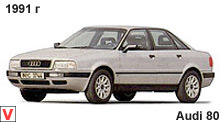
Audi's five-cylinder engines are very sensitive to the level of coolant and underfilling of oil. Particularly valuable quality machines for domestic operating conditions should be considered an excellent corrosion resistance galvanized body, which does not rust our salty winter, even in those places where the paint flew off. Four-door sedans Audi 80 (series B4) in November 1994 was replaced by a model of the new generation A4. At the end of 1995, Avant was also shot.
Particularly valuable quality machines for domestic operating conditions should be considered an excellent corrosion resistance galvanized body, which does not rust our salty winter, even in those places where the paint flew off. Four-door sedans Audi 80 (series B4) in November 1994 was replaced by a model of the new generation A4. At the end of 1995, Avant was also shot. Particularly valuable quality machines for domestic operating conditions should be considered an excellent corrosion resistance galvanized body, which does not rust our salty winter, even in those places where the paint flew off.
Four-door sedans Audi 80 (series B4) in November 1994 was replaced by a model of the new generation A4.
